HORSEPOWER HUBRIS 2007-2010
Gouache on archival digital print/ Hahnemühle paper.
The automobile and all of its wheeled cousins transformed the 20th century; their role in the 21st gets more complicated. Once offering mobility, status and power, their incessant and increasing need for oil has created gridlock, corporate and manufacturing crises, and dependencies that threaten personal and national autonomy, world peace and the environment. The U.S. Department of Defense is the single largest domestic consumer of petroleum, feeding earth and air bound machines that are instrumental in conducting military operations around the world.* Away from war, the private cocoons of civilian cars still prevail over mass transit, further exhausting resources. These conditions drive global politics and hasten ecological catastrophe.
Benign or malignant, machines on wheels can be seen as both emblems and enforcers of "freedom.” They can appeal to our sense of leisure and luxury, perform functionally or instill fear. Seductive and destructive, vehicles have become favored as both weapons and targets of those who have chosen violence as a means to an end. Cars, Humvees, Strykers, tanks, and jeeps have come to embody the machismo that both feeds and entraps so many abuses of power.
*Presentation by American Petroleum Institute President and CEO Red Cavaney held at the USAF/API Awards Banquet – Arlington, Virginia, July 15, 2004. See also National Defense Magazine article in 2002.
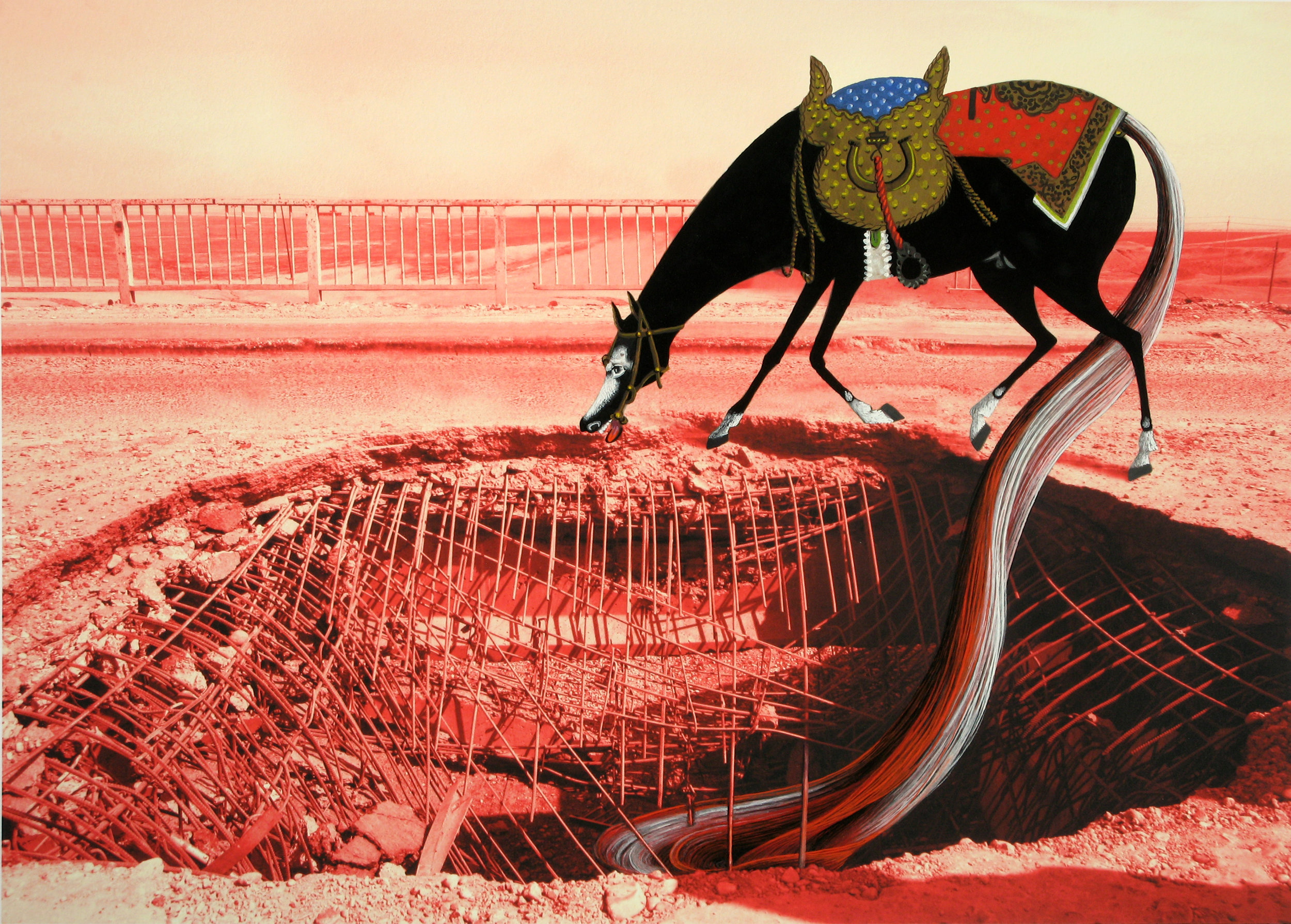
REPLENISH 2010
Gouache on archival digital print/Hahnemühle paper,10 x 14 inches. 17 x 20.625 inches framed. 43 x 52.3cm
Horse derived from Khusraw discovers Shirin bathing in a pool from a Khamseh (Quintet) by Nizami, mid 16th century Safavid dynasty from Shiraz, Iran. Smithsonian, Gift of Charles Lang Freer, F1908.262a-b. Photo source of bridge in Mosel, Iraq: FLICKR, JamesDale10.
A thirsty horse from a 16th century Persian painting stands on the edge of a crater of a bombed bridge in Mosel, Iraq. Its empty saddle suggests a fallen warrior; its tail flows into the cavity like a river of blood.
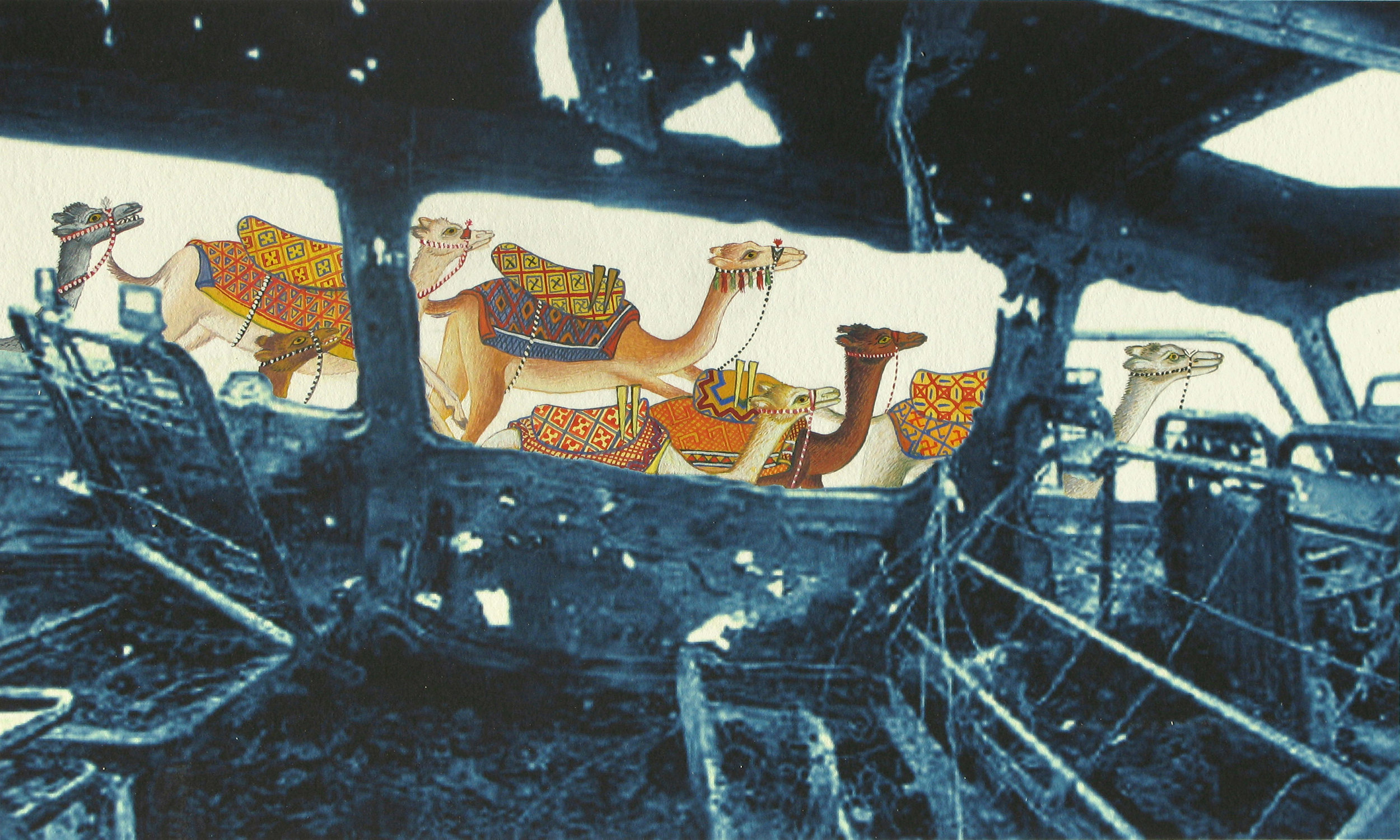
ROAM: Riding on Remorse 2008
Gouache on archival digital print/Hahnemühle paper, 6 x 10 inches
Collection of Mary Lou Arscott, Pittsburgh PA.
Camels by Bihzâd for Nizâmî’s Layli and Manjûn in 1493 Khamseh, British Library; photo: Carlos Osorio, Toronto Star
Windows of a car bomb frame a caravan of camels derived from a 15th c. painting by Bihzâd, the master of Persian miniatures. It contrasts vehicles both ancient and contemporary that move people—or massacre them.
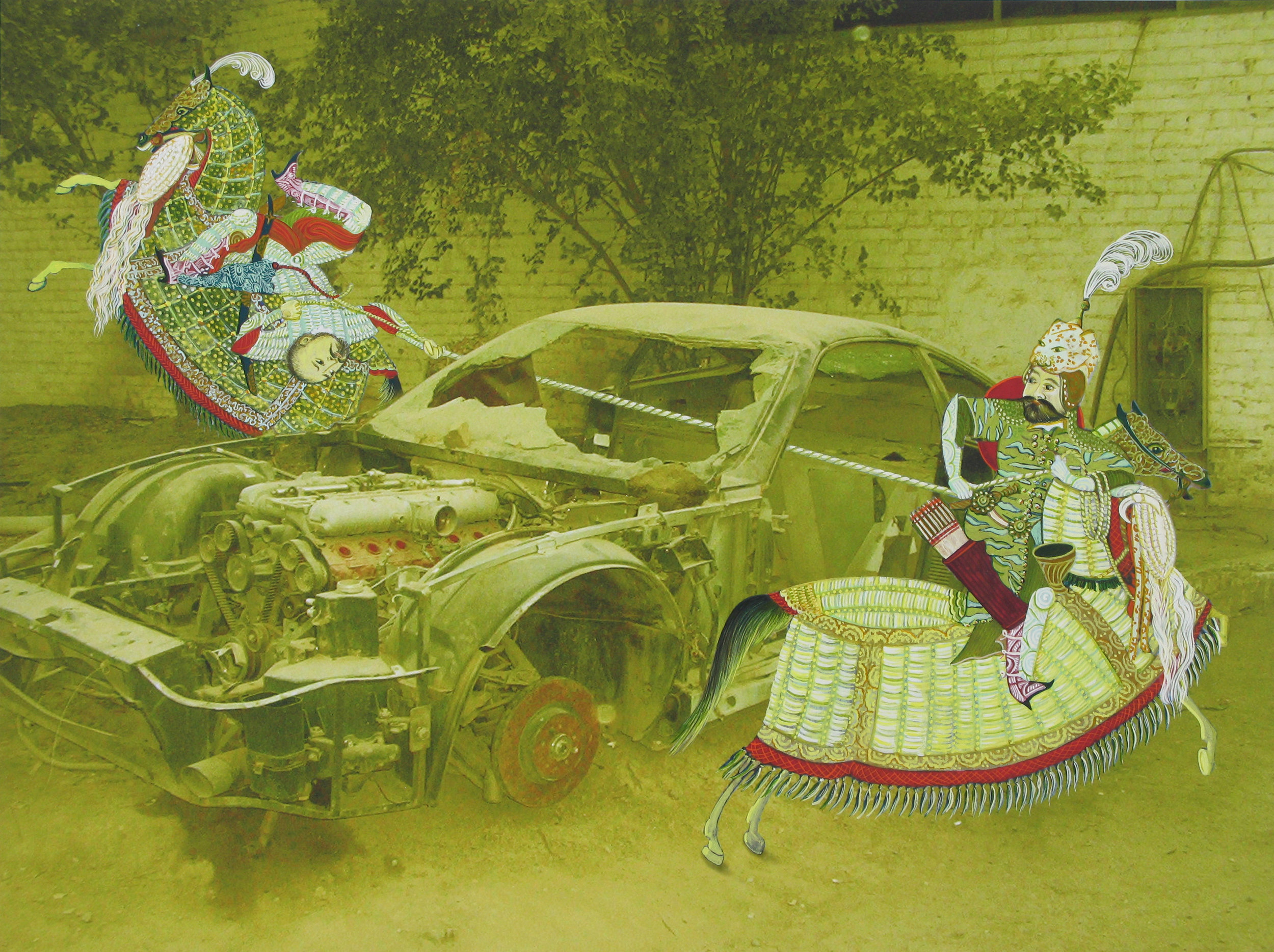
TUG OF WAR, 2009
Gouache on archival digital print/Hahnemühle paper, 12 x 14 inches.
Photo source by JamesDale10 on FLICKR of Uday Saddam Hussein’s Ferrari. Horsemen derived from the Combat of Rustam and Kâmus in Shah Tahmãsp’s Shãhnãmeh, fol.271a, attributed to “Abd al-Vahhãb, c.1530. Tehran Museum of Contemporary Art.
Uday Saddam Hussein and his brother Qusay were killed by a TOW missile strike conducted by US Special Operations and 101st Airborne Division on July 22, 2003. Uday had an extensive exotic car collection. Tug of War includes an image of his Ferrari 500 Maranello, purportedly destroyed by our armed forces as well. It provides the set for a “tug of war” of more ancient warriors in all their finery, speaking to the sad continuity and ritual of war. From the innocent game involving only a rope to complex operations involving Tube-launched, Optically-tracked, Wire-guided (TOW) anti-tank missiles, Tug of War reveals our preoccupation with war, from cradle to grave.
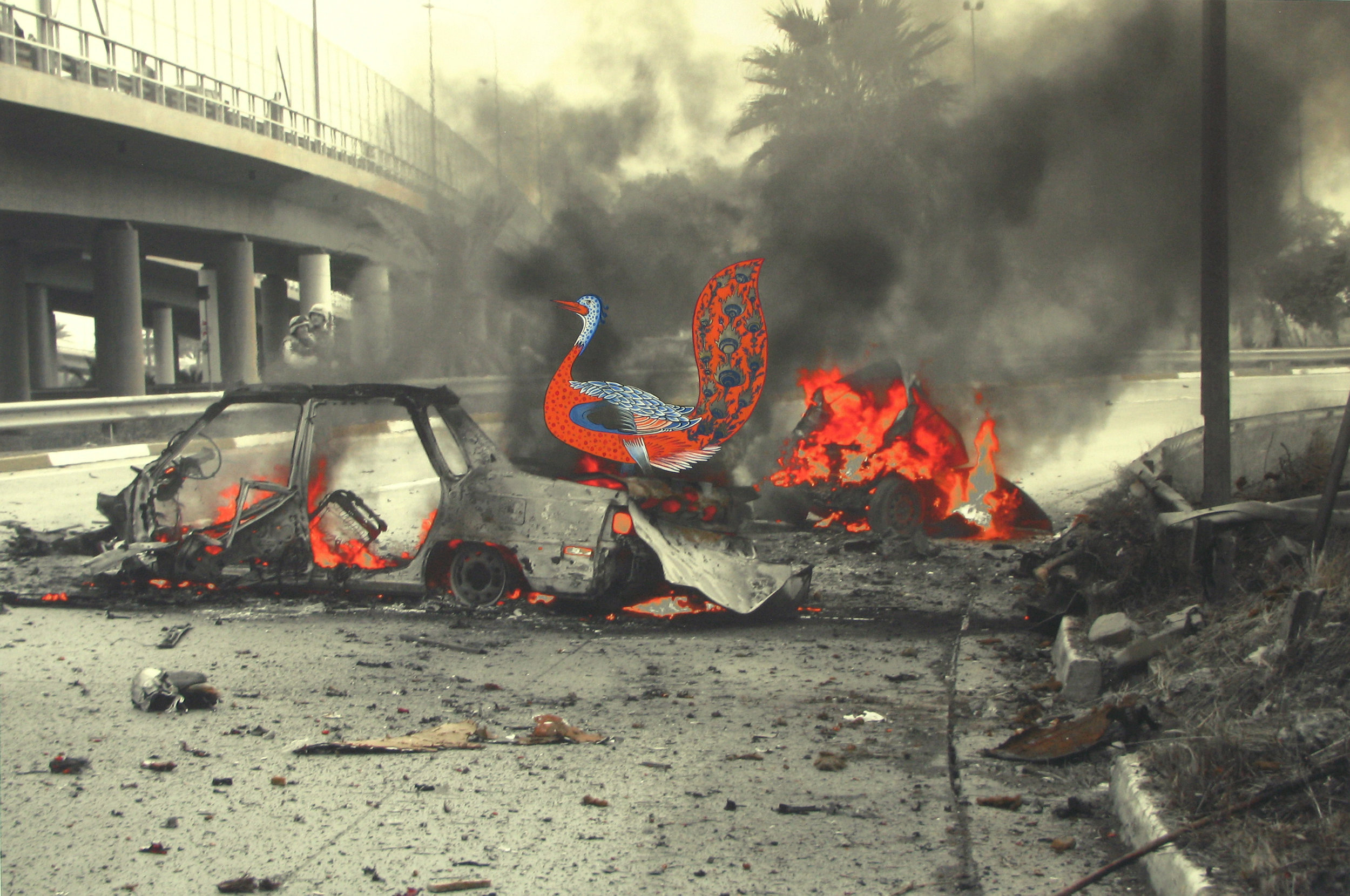
REBIRTH: EVE'S ESCORT 2007
Gouache on archival digital print/Hahnemühle paper, 16 x 24 inches. Peacock from Adam and Eve in the Falnameh of Ja’far al-Sâdiq, Arthur M. Sackler Gallery, Smithsonian Institution, Washington, D.C., S1986.251; photo from Mike Shiley’s film Inside Iraq: The Untold Story
Rebirth: Eve’s Escort refers to the dragon and peacock that respectively bore Adam and Eve. The mythical peacock that bore Eve is a feminine, living counterpart juxtaposed with the inanimate masculine vehicle. Radiating beauty behind a burning automobile, Eve (even if absent) and her bird represent a generative life force that persists despite the surrounding devastation.
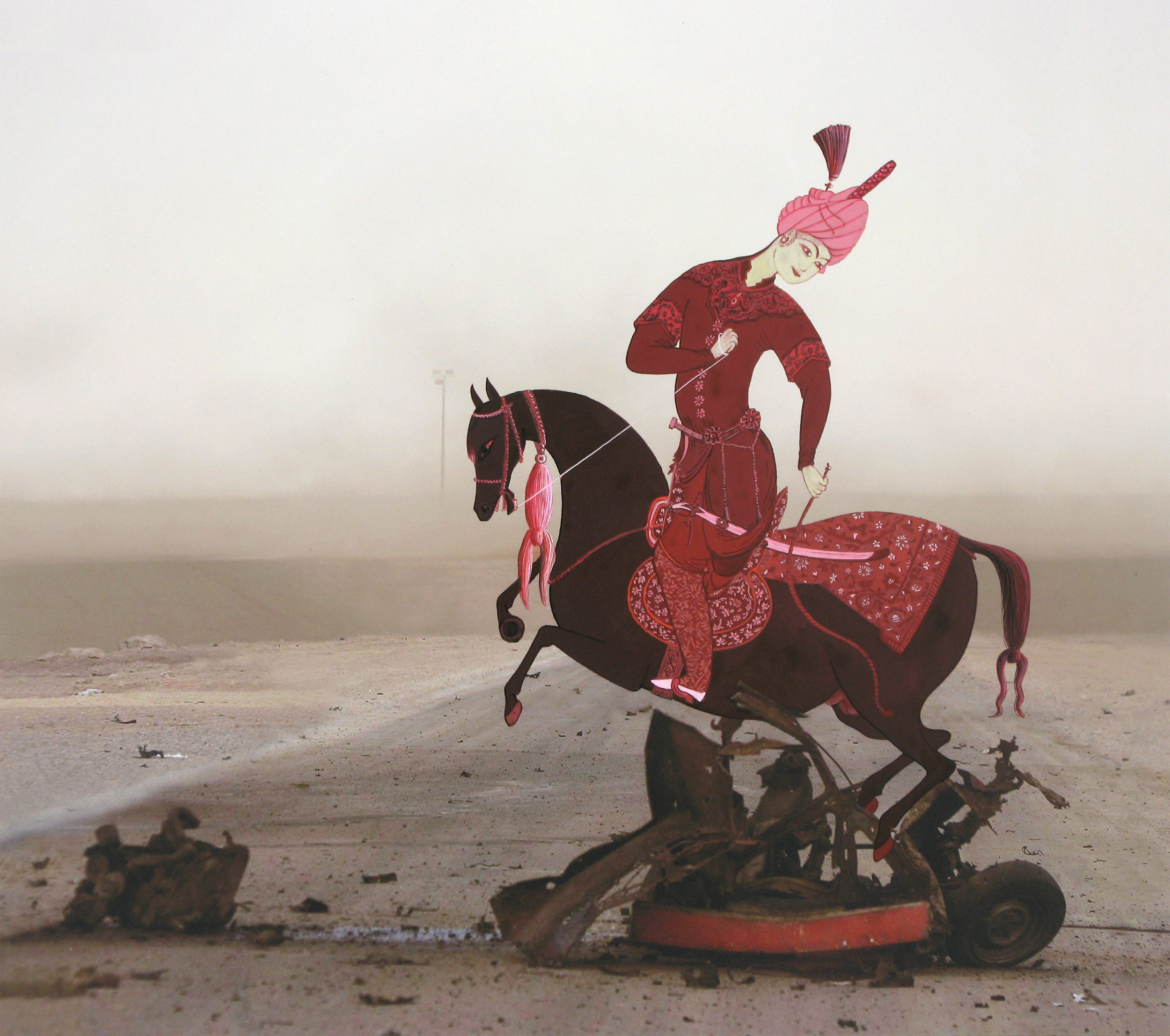
ROCKING HORSE 2010
Gouache on archival digital print/Hahnemühle paper, 12 x 13.5 inches, 19.5 x 20.5 inches framed. Horseman derived from Horseman and Running Page, attributable to Qadimi Qazvin, c.1560, Arthur Sackler Museum, Harvard University Art Museums, no. 1958.62.2. Photo sources: FLCKR Sea King, in southern Iraq by meesterlowehttp://www.flickr.com/photos/meester_lowe/39038751/in/photostream
http://www.harvardartmuseums.org/collection/detail.dot?objectid=1958.62&globalSearchText=qadimi
A horseman derived from a 16th century painting by Qadimi is mounted above the wreckage in a southern Iraqi landscape, suggesting how we continue to treat war as a game, from cradle to grave.
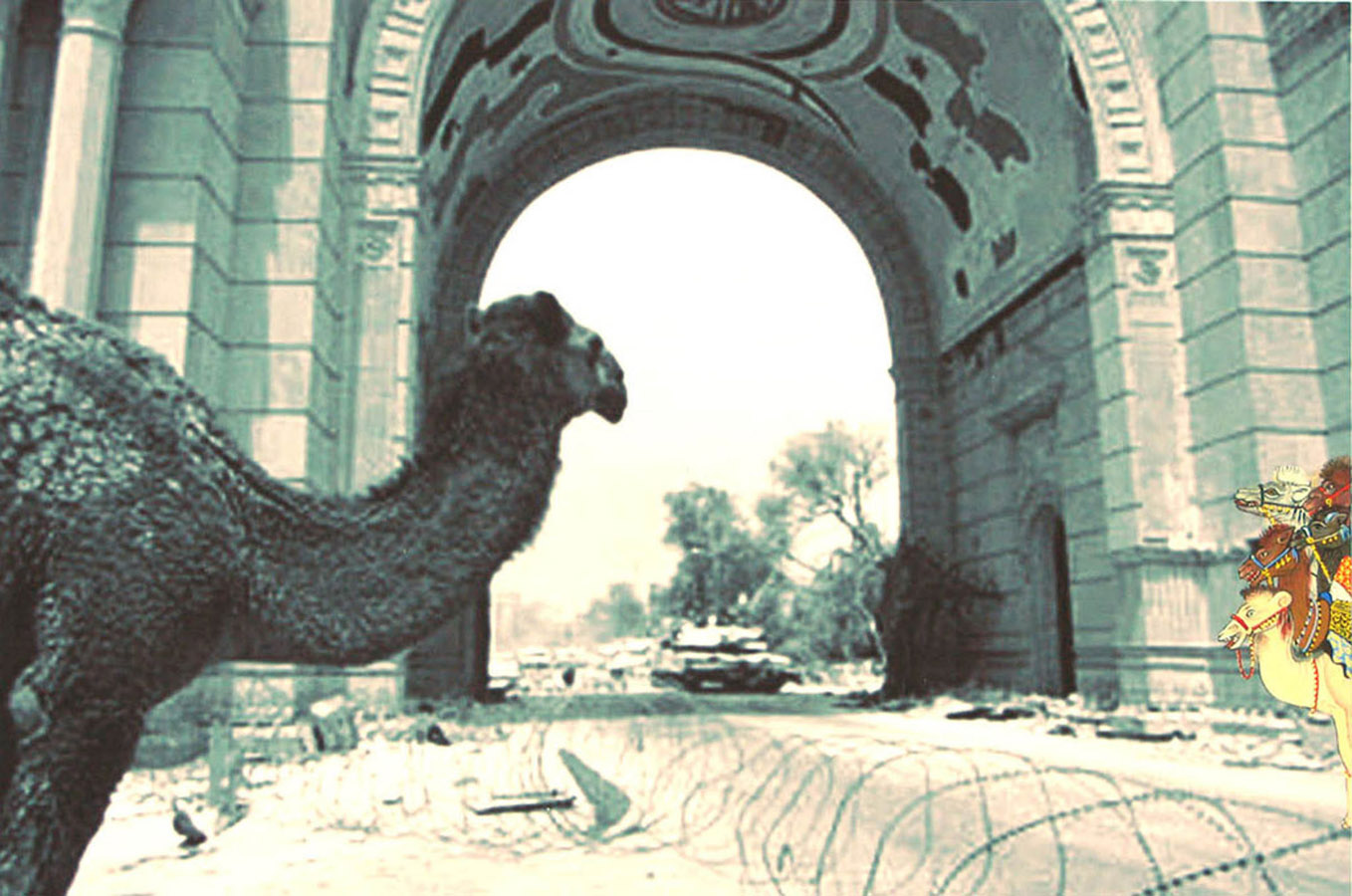
RENDEZVOUS 2007
Gouache on archival digital print/Hahnemühle, 8 x 12 inches.
Collection of Michael Murphy, Pittsburgh PA.
Camels from frontispiece of bound manuscript of the Silsilat al-Dhahab of Jãmi, copied by Shãh Mahmud al-Nishãpuri on 8/25/1549, attributable to Mirzã ‘Ali Tabrîz, 1540–45, National Library of Russia; photo: US tanks at the presidential complex in Baghdad with only a camel for company. Photograph: John Moore/AP, Guardian April 16, 2003
http://www.guardian.co.uk/world/2003/apr/16/iraq.jamesmeek
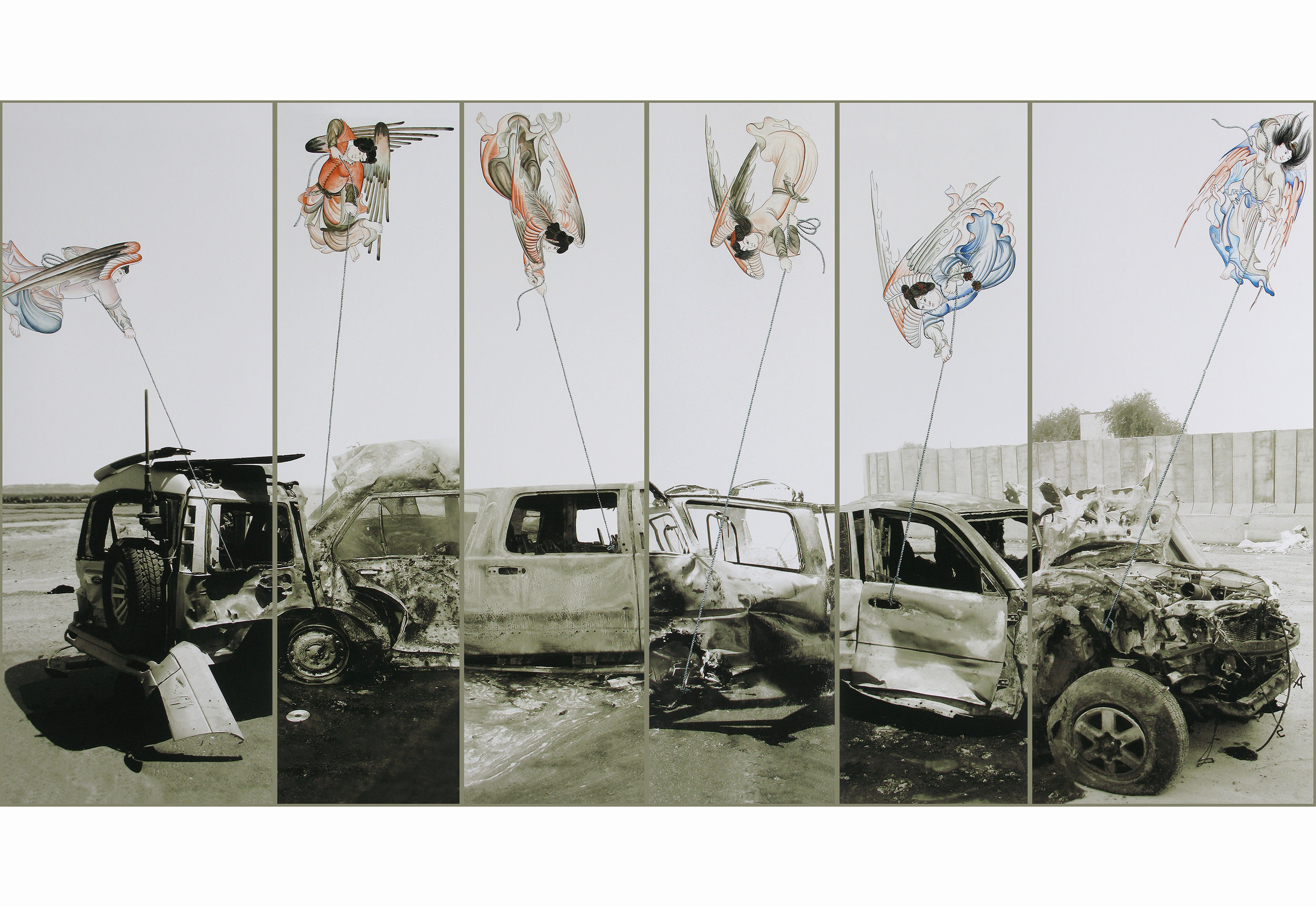
STRETCH 2009
Gouache on archival digital print/Hahnemühle, 72 x 132inches, total with six framed panels.
Angels derived from School of Muhammed Siyâh-Qalam illumination. Tabrîz, c.1478-90. Library of the Topkapì Sarayì Museum, Istanbul. H. 2153,fol. 5v.
Whether benign or malignant, cars, jeeps, tanks and humvees have come to embody the machismo that both feeds and entraps so many abuses of power. The intertwining of death and renewal recurs in the “Horsepower Hubris” series that focuses on vehicles of violence. The angels in “Stretch” are derived from an illustration for Nizâmi’s “Tale of the Turquoise Pavilion,” where they struggle with a seven-headed dragon in an allegory of the soul’s journey through the lower world. In “Stretch,” the dragon is replaced by the charred remains of an impossible stretch limousine, pieced from sections of multiple bombed cars. The angels must deal with the proliferation and aftermath of violence.
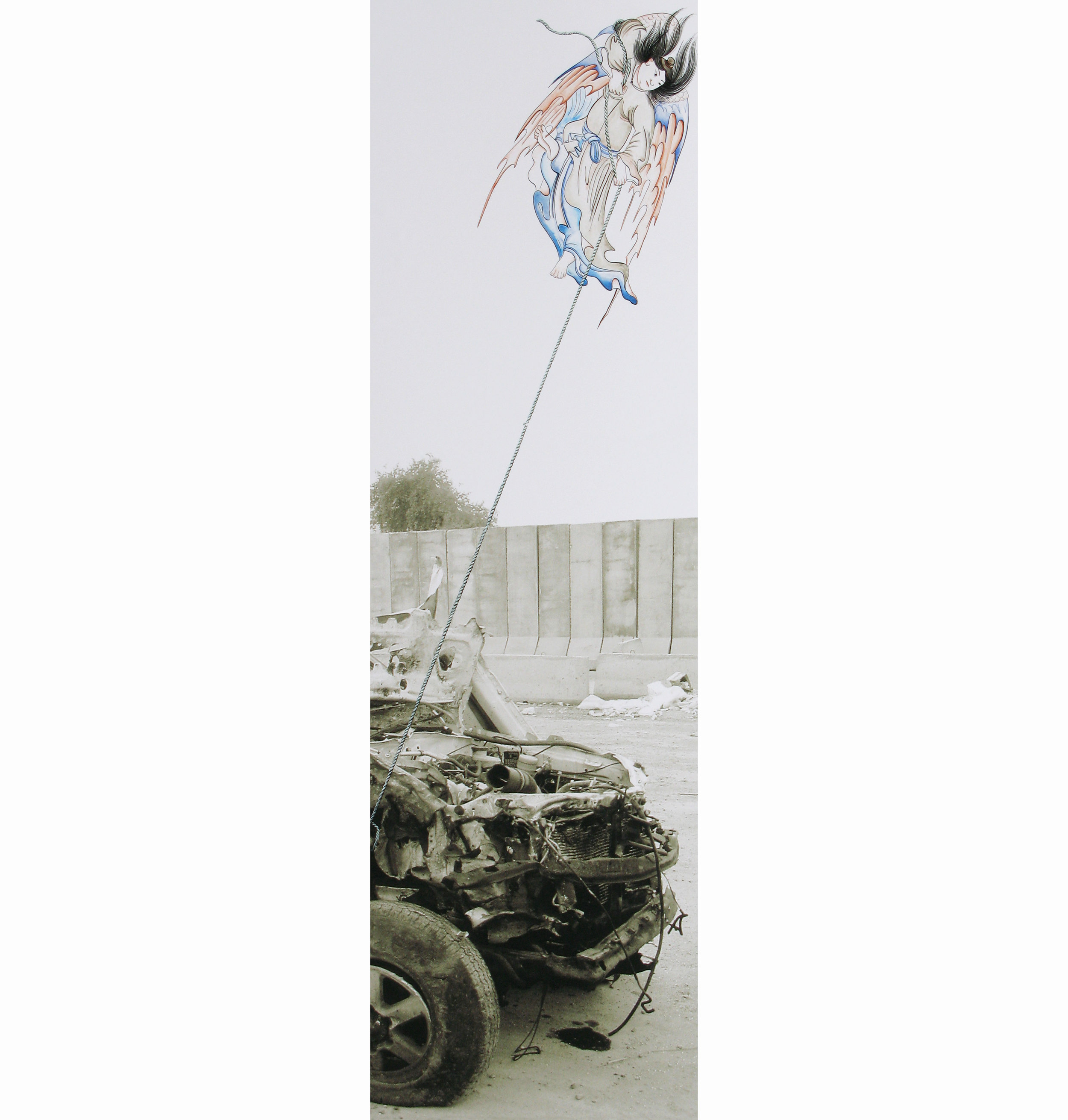
Detail from STRETCH 2009
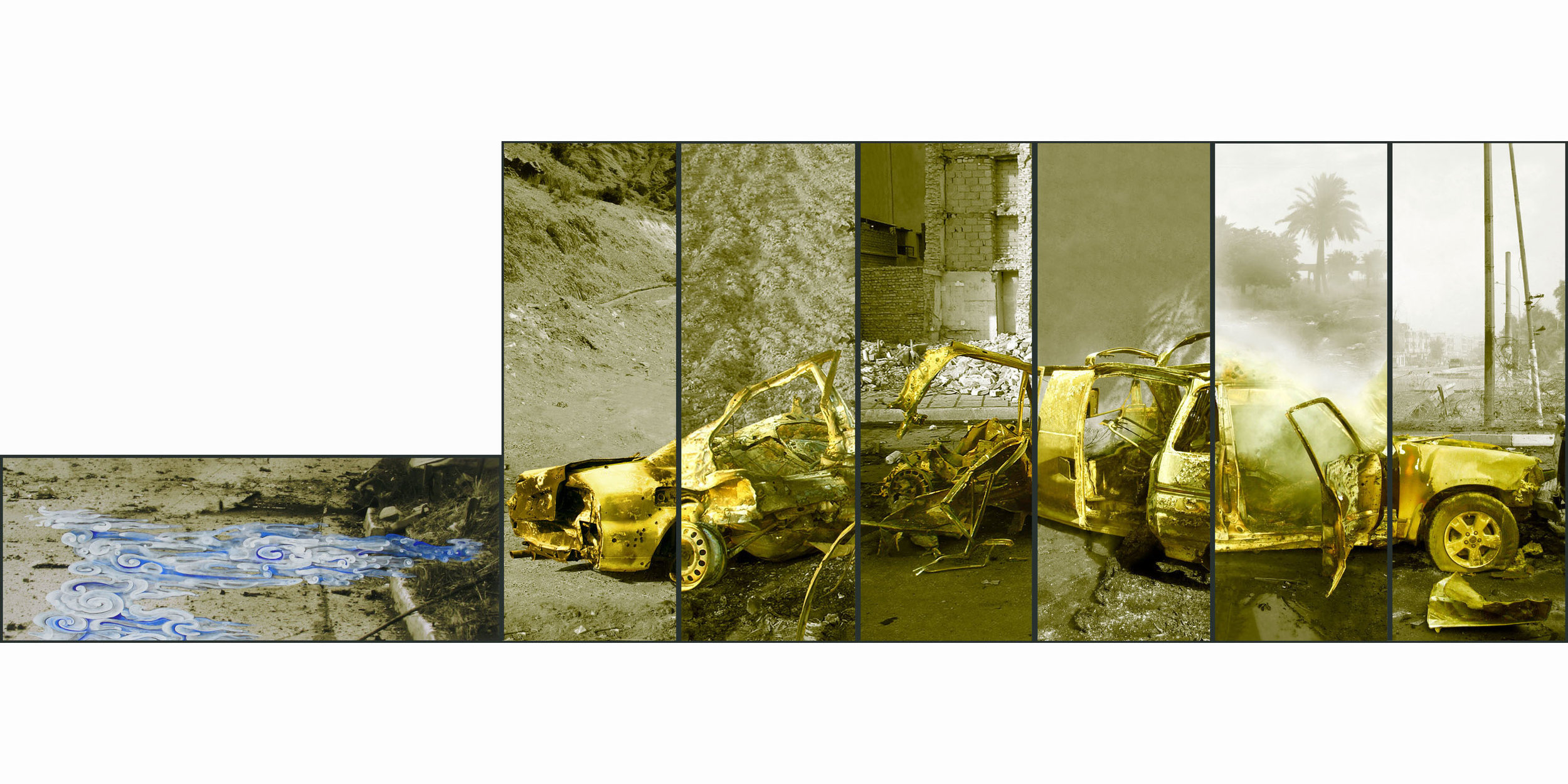
EXHAUST 2009
Gouache on archival digital print/Hahnemühle paper, 60 x 185 inches, 7 framed panels. Each panel 61” x 22” framed.
The exhaust cloud trailing from another “stretch” limo in Exhaust can be seen as respiration or expiration, some faint breath that survives our best efforts to destroy. It is either the last gasp or a sign of survival. These works invite us to consider harnessing our horsepower with less lethal impact in every dimension of our lives.
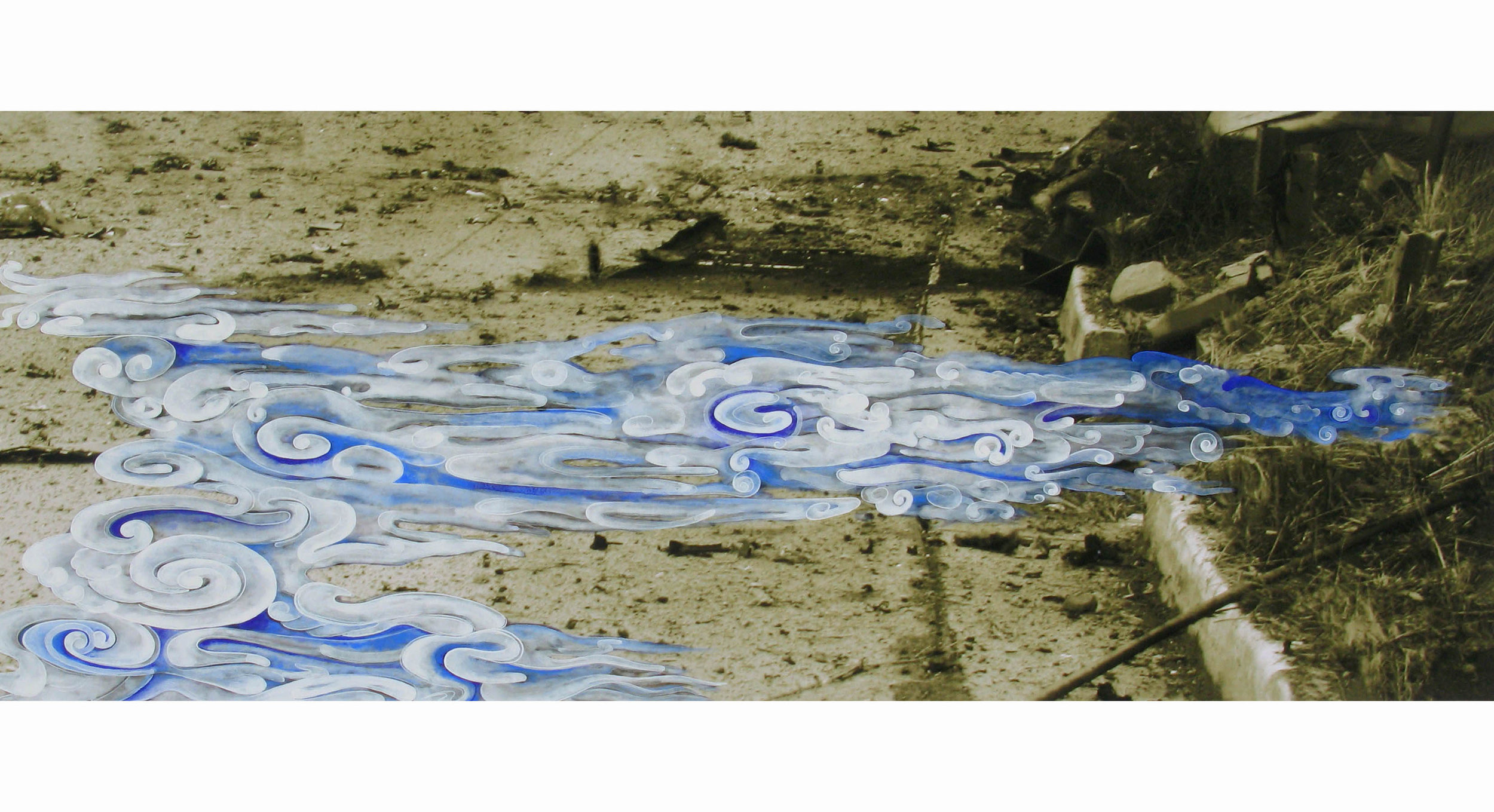
Detail from EXHAUST 2009
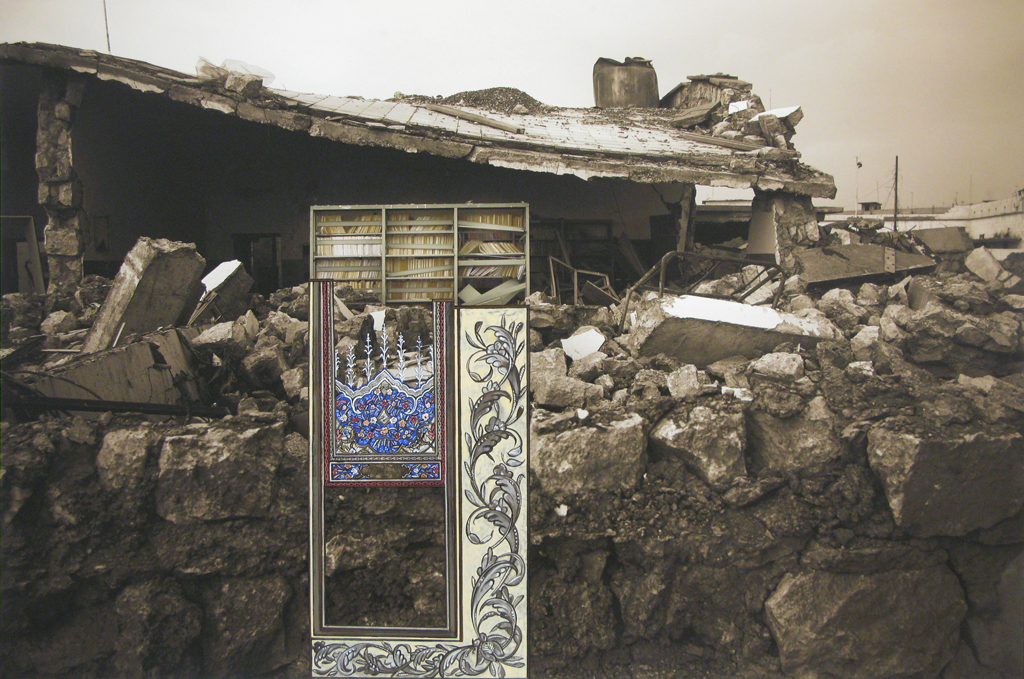
GOOD DEEDS, 2009
Gouache on archival digital print/Hahnemühle, 24 x 36 inches. Photo source: Tightsqueez, 665 Days set, Iraq 2008 on FLICKR. Illumination derived from hand-colored illumination, 1793, from Dala'il al khayyirat (Guide to good deeds) by Muhammad ibn Sulayman Jazuli, d. 1465, 1v-2r, Beinecke Rare Book and Manuscript Library, Yale University.
The modified illumination from Dala'il al khayyirat (Guide to good deeds) is superimposed on a photographic image of a single bookcase left standing untouched in the rubble of contemporary Ramadi, suggesting the persistence of knowledge and culture across ages of warfare.
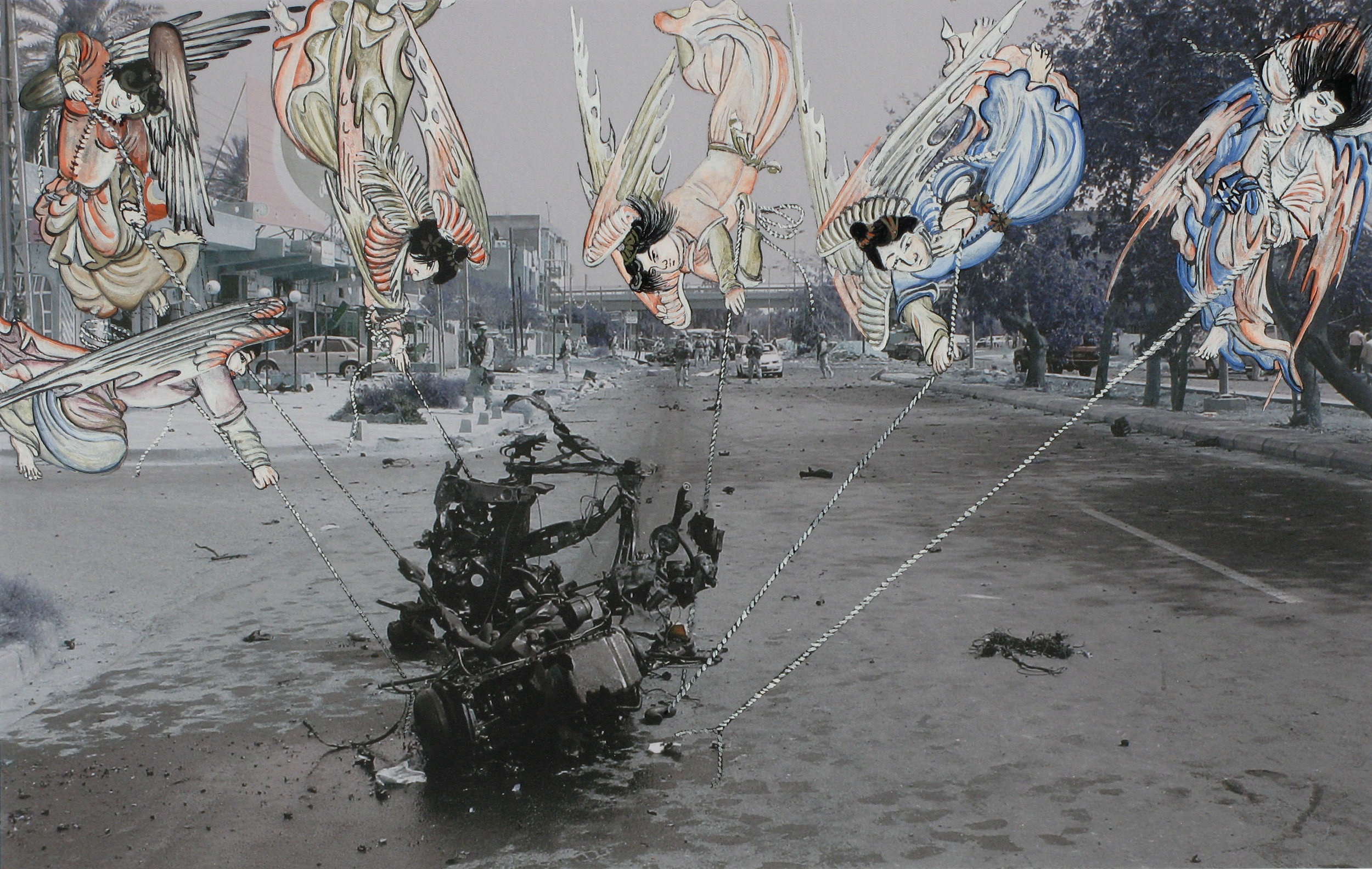
TENDING THE EMBERS 2009
Gouache on archival digital print/Hahnemühle paper, 6.33 x 10 inches.
Angels derived from School of Muhammed Siyâh-Qalam. Tabrîz, c.1478-90. Library of the Topkapì Sarayì Museum, Istanbul. H. 2153,fol. 5v.
Whether benign and malignant, cars, jeeps, tanks and humvees have come to embody the machismo that both feeds and entraps so many abuses of power. They have become essential to those who choose violence as means to an end.
Whether benign and malignant, cars, jeeps, tanks and humvees have come to embody the machismo that both feeds and entraps so many abuses of power. They have become essential to those who choose violence as means to an end. Angels are hand- painted over an internet photograph of an explosion site. Engaging with the remains of a VBIED (vehicle-born improvised device, are they coming to the rescue or poking resignedly at the charred tangle? Are they stoking the fire of revenge or hoisting the carcass of tragedy in a laborious ascension?
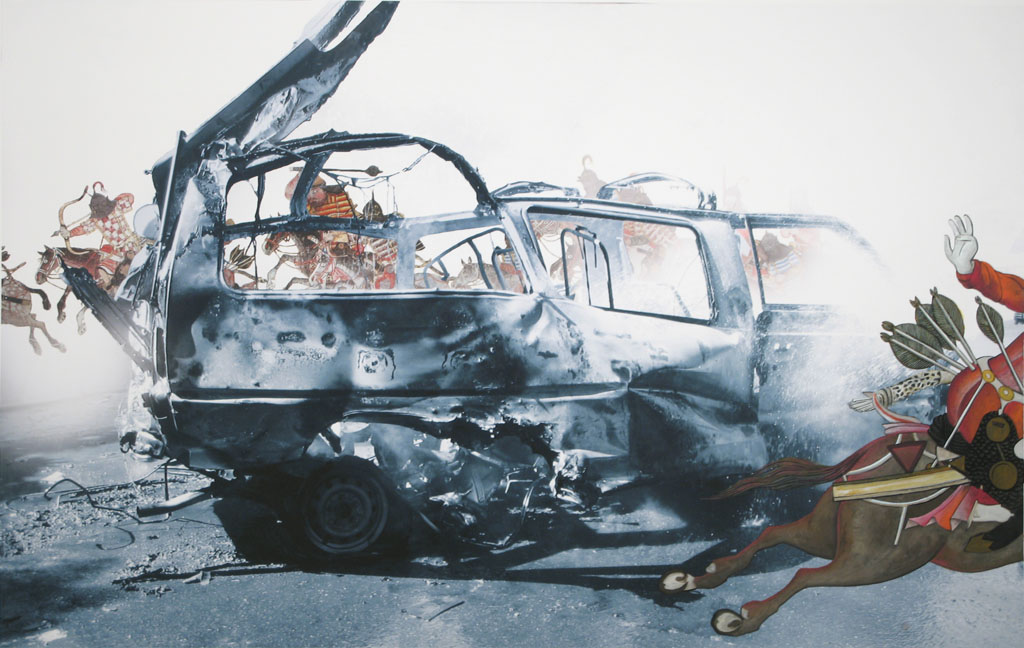
HEADLONG 2009
Gouache on archival digital print/Hahnemühle paper, 15 x 24 inches. Photo source by Sam de Silva of car bomb in Sri Lanka. Warriors derived from an illustration to Firdawsî’s Book of Kings from the manuscript copied in Tabrîz for the Mongol íl Khân Abû-Sa ‘id (r.1317-35), and dispersed in the early 20th century by the dealer Georges Demotte in Paris. Musée du Louvre, Paris. Antiquités orientales, section islamique nº7095. The warriors accompany the Book of Kings’ hero Faramurz who scatters the troops of the king of Kabul (with all the horsemen wearing contemporary Mongol armor). In Headlong, theyrace around a contemporary image of a car bomb in Sri Lanka. The white glove of the rider exiting the scene extends in what couls be seen as commanding gesture: Halt this madness.
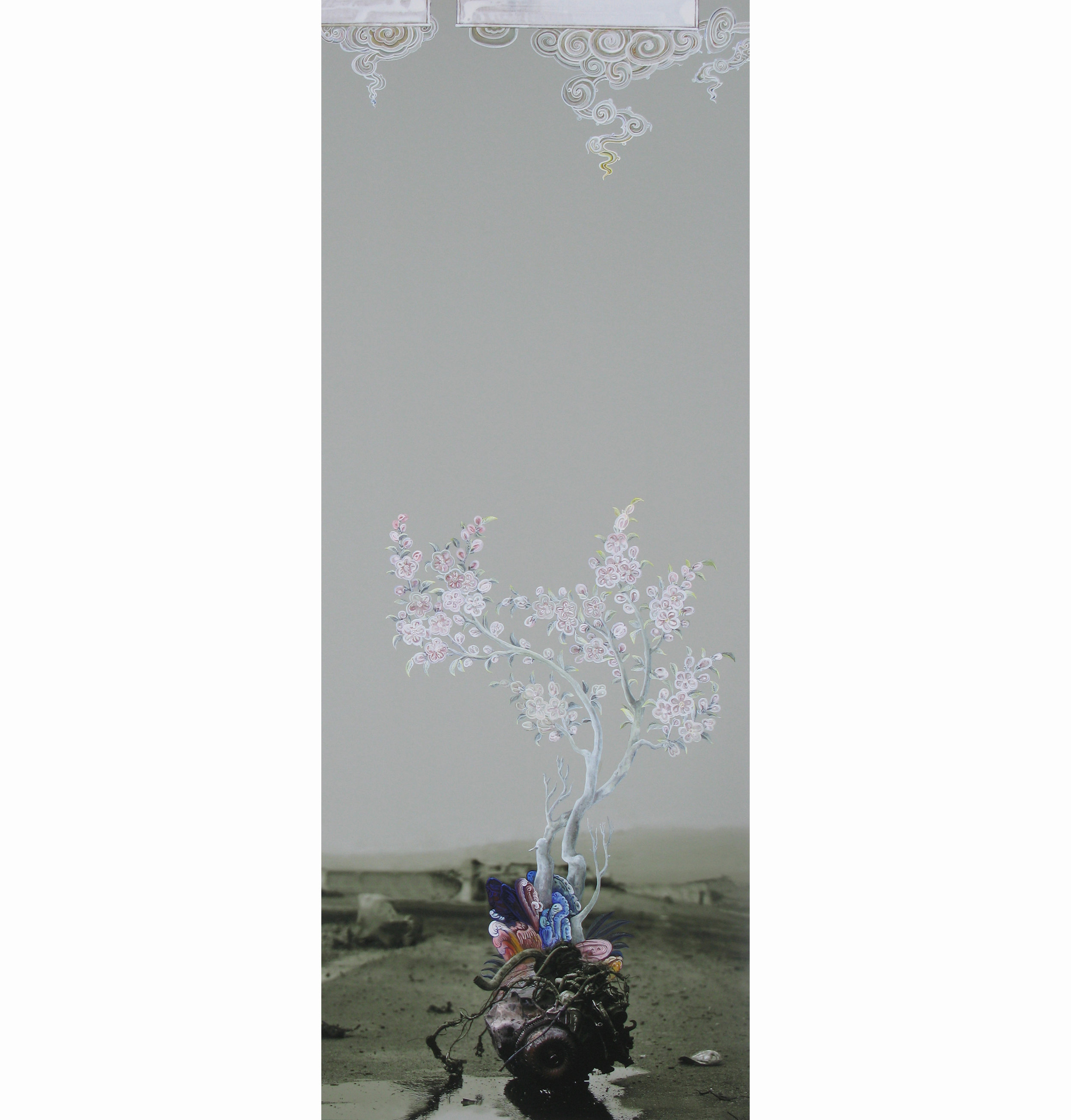
RESPLENDENT, 2010
Gouache on archival digital print/Hahnemühle paper, 60 x 23 inches; 62 x 25 in framed.
Tree derived from The Hero Rustam Slays the Witch of the Cosmic Illusion; an illustration attributed to Qadîmî by S.C. Welch. From Fidawsî’s Shahnameh (Book of Kings), copied in Tabrîz from Shâh Tahmâsp between the 1520’s and 1540’s. Fol. 120v. Metropolitan Museum of Art, New York. Photo source: FLICKR_SSG Wayne Speek VBIED Afghanistan.
In Resplendent, a tree grows out of the remains of an improvised explosive device (IED) on a deserted road. The tree is derived from a 16th century illustration, The Hero Rustam Slays the Witch of the Cosmic Illusion attributed to Qadîmî from Fidawsî’s Book of Kings. The IED is from a FLICKR image taken in Afghanistan by SSG Wayne Speek. The landscape is a photoshop composite from multiple sources.
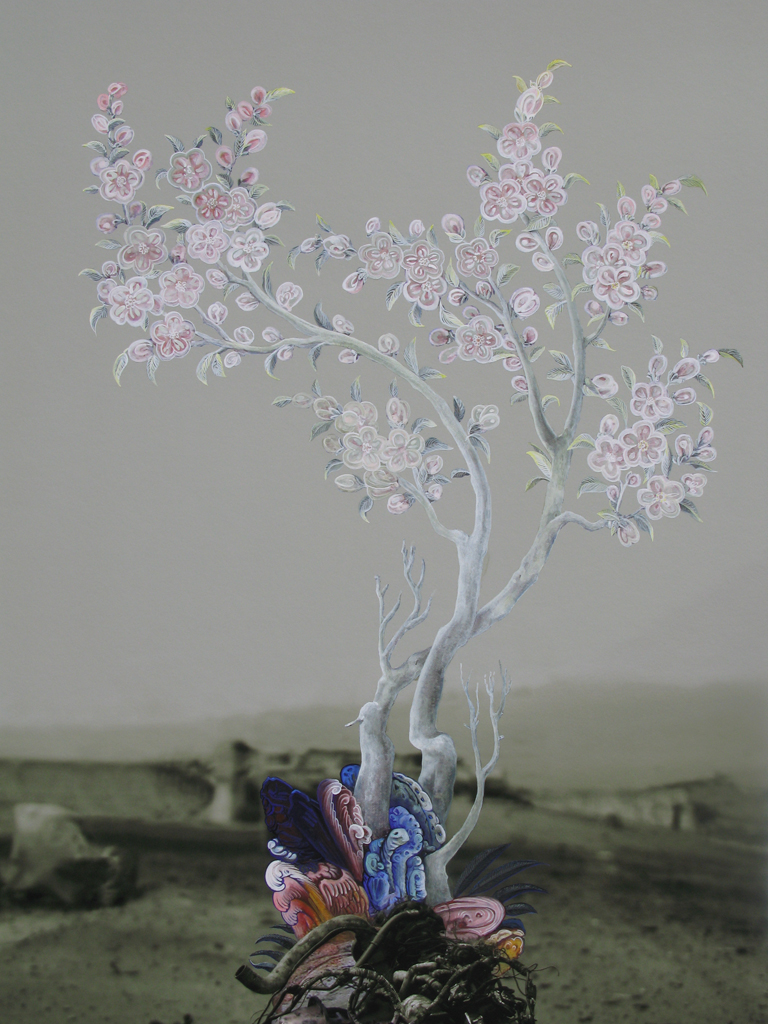
Detail of RESPLENDENT
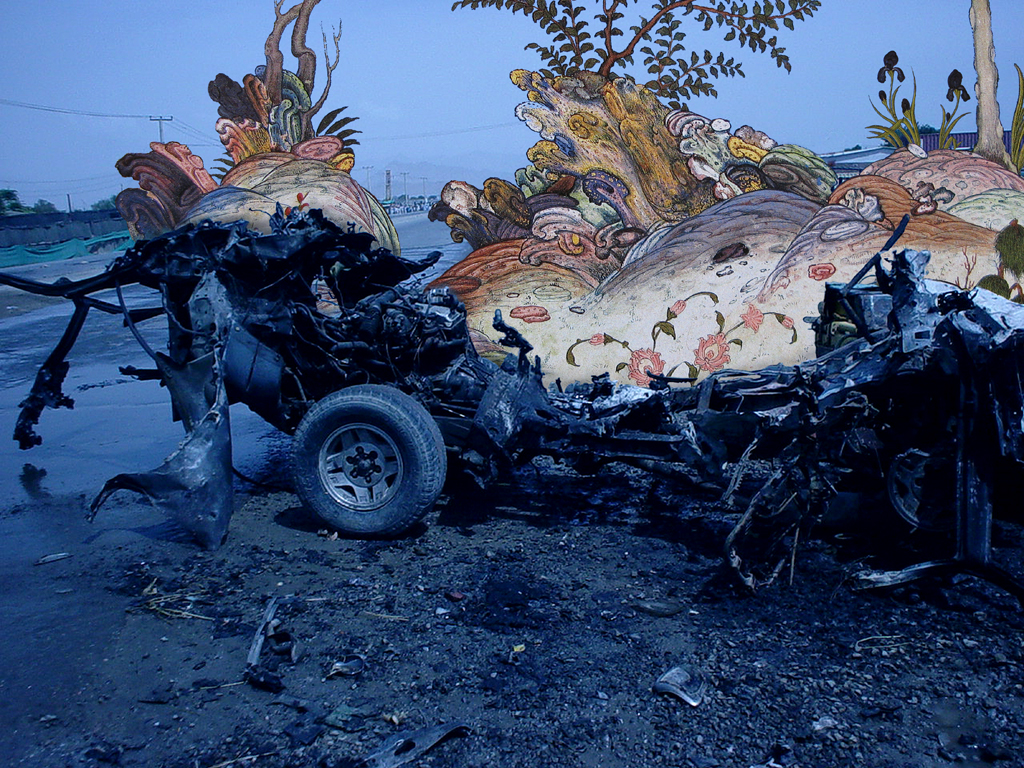
RECALL, 2012
Digital print on Hahnemühle paper, 11.5 x 15.25 inches.
Sources: altered photograph from Flickr_Ajmal Aand, August 27, 2002 with mountains from The Hero Rustam Slays the Witch of the Cosmic Illusion; an illustration attributed to Qadîmî by S.C. Welch. From Firdawsî’s Book of Kings, copied in Tabrîz from Shâh Tahmâsp between the 1520’s and 1540’s. Fol. 120v. Metropolitan Museum of Art, New York http://www.flickr.com/photos/aand/395304349/in/photostream
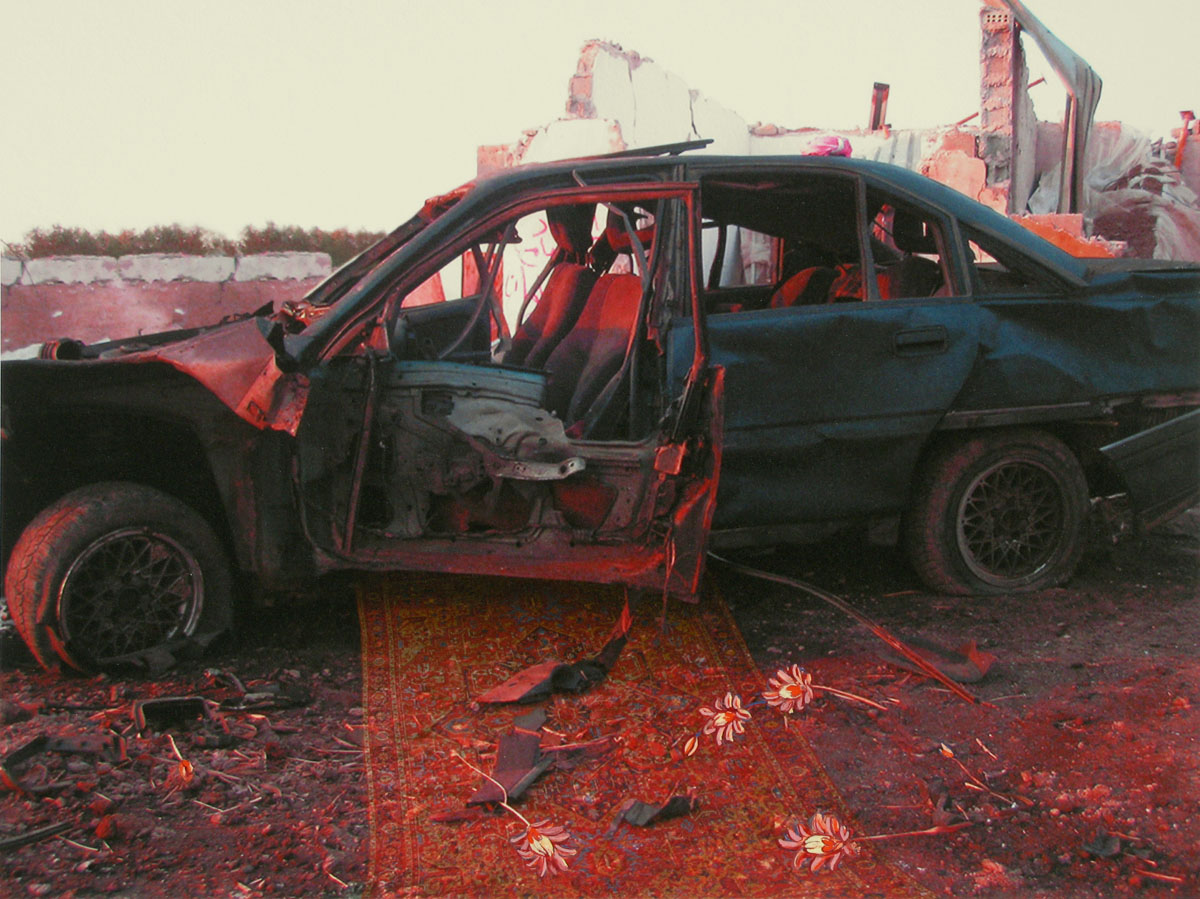
RED CARPET, 2009
Gouache on archival digital print/Hahnemühle, 6 x 8 inches. Photo source from pmcleary Iraq album on FLICKR. Angels derived from School of Muhammed Siyâh-Qalam. Tabrîz, c.1478-90. Library of the Topkapì Sarayì Museum, Istanbul. H. 2153,fol. 5v.
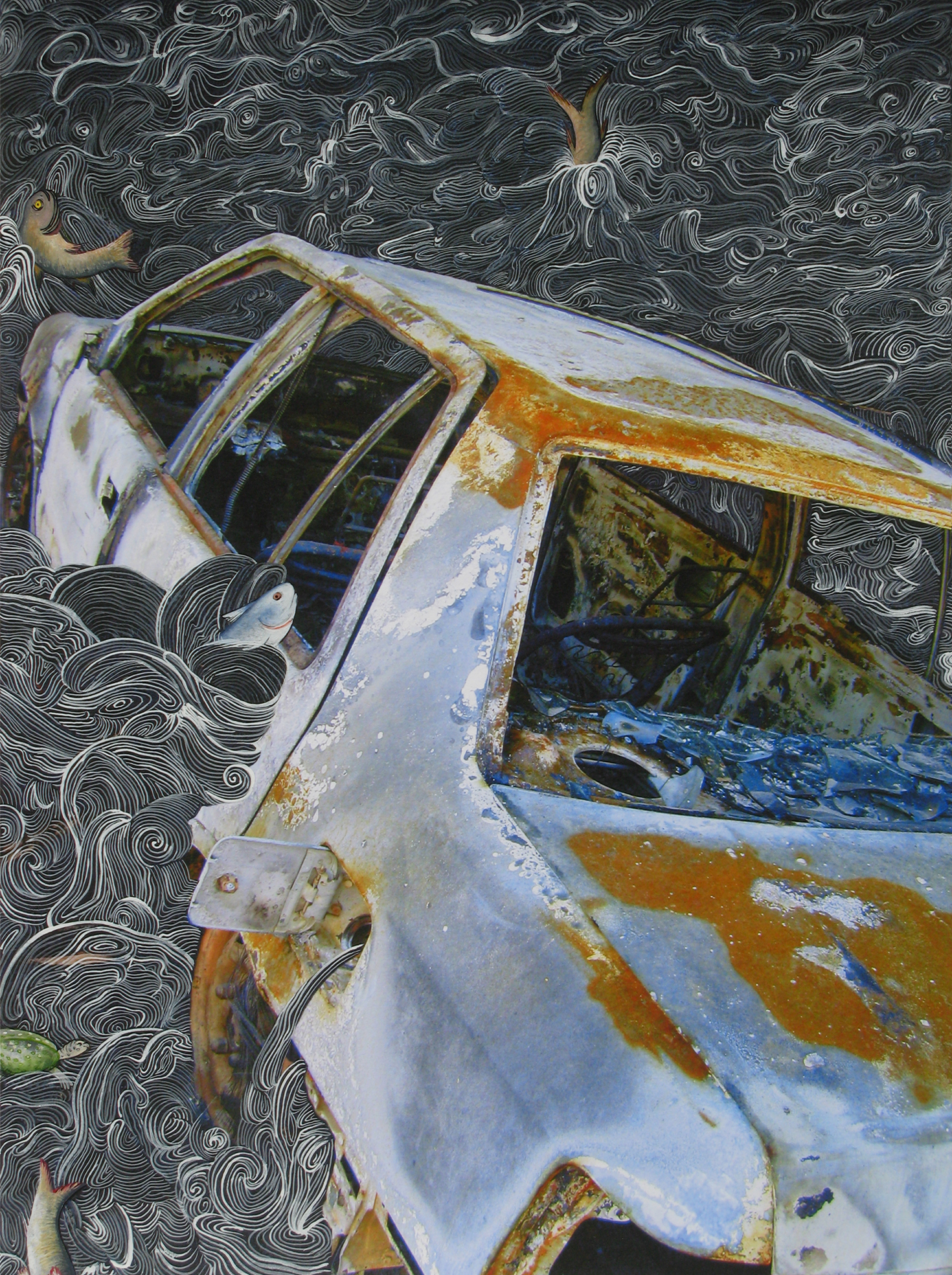
HEMORRHAGE, 2009
Gouache on archival digital print/Hahnemühle 16 x 12 inches. Water motifs derived from illustration for The Adventures of Hamza, attributed to Banavari and Mah Muhammad, Volume 11, painting number 91, text number 92, India, Mughal dynasty, circa 1570, MAK – Austrian Museum of Applied Art/Contemporary Art, Vienna, B.I. 8770/32; Photo source by djagger1 on FLICKR.
Here a trickle of black fluid (oil?) leaks from a gas tank, creating a deluge. “Hemorrhage” speaks to limited resources and over-consumption and the morass that both create. The creatures caught in the flood are just the smallest victims of an economy and politics all too heavily dependent on the culture of the automobile.

MAGIC MOUNTAIN, 2009
Gouache on archival digital print/ Hahnemühle, 15 x 10 inches.
Birds and rocks derived from Shah Tahmãsp’s Shãhnãmeh, Rustam recovers Rakhsh from Afrãsiyãb’s herd attributed to fol. 295a, attributed to Mirzã ‘Ali, 1530-35, from private collection, Lichtenstein. Photo Source: James Dale, truck Bomb, Tal Afar, Iraq.
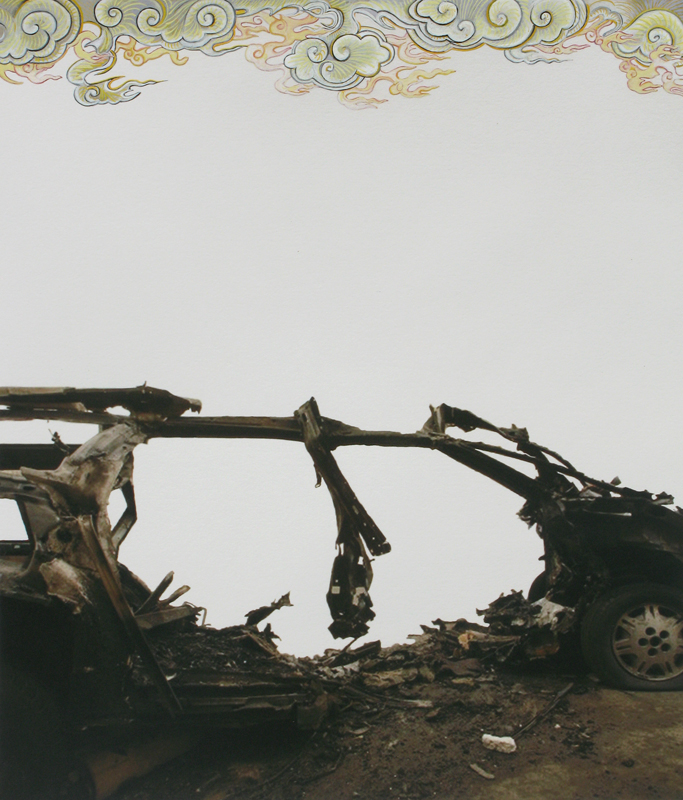
HEAVEN'S GATE, 2009
Gouache on archival digital print/Hahnemühle, 14 x 12 inches. Sources: Baghdad_Getty images; clouds from an illustration to Firdawsî’s Book of Kings from the manuscript copied in Tabrîz for the Mongol íl Khân Abû-Sa ‘id (r.1317-35), and dispersed in the early 20th century by the dealer Georges Demotte in Paris. Musée du Louvre, Paris. Antiquités orientales, section islamique nº7095. The clouds hover above the hero Faramurz scattering the troops of the king of Kabul (with all the horsemen wearing contemporary Mongol armor).
The clouds above a charred automobile in Baghdad are derived from a Persian battle scene illustration with the hero Faramurz scattering the troops of the king of Kabul. The persistence and futility of violence across nations and empires is reiterated in the blasted out windows and doors that open to a bleached out void. Is it the blinding light of paradise, the motive for so much “martyrdom,” or nothing but a dead end?